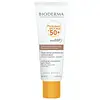What's inside
What's inside
 Key Ingredients
Key Ingredients

 Benefits
Benefits

 Concerns
Concerns

 Ingredients Side-by-side
Ingredients Side-by-side

Water
Skin ConditioningDibutyl Adipate
EmollientOctocrylene
UV AbsorberMethylene Bis-Benzotriazolyl Tetramethylbutylphenol
UV FilterTetrabutyl Ethylidenebisphenol
AntioxidantPropanediol
SolventButyl Methoxydibenzoylmethane
UV AbsorberGlycerin
HumectantDicaprylyl Carbonate
EmollientBis-Ethylhexyloxyphenol Methoxyphenyl Triazine
Skin ConditioningAscorbyl Glucoside
AntioxidantCorn Starch Modified
AbsorbentDicaprylyl Ether
EmollientSilica
AbrasiveTocopherol
AntioxidantCetearyl Alcohol
EmollientDecyl Glucoside
CleansingC20-22 Alkyl Phosphate
EmulsifyingC20-22 Alcohols
Emulsion StabilisingHydroxyethyl Acrylate/Sodium Acryloyldimethyl Taurate Copolymer
Emulsion StabilisingCoco-Glucoside
CleansingPentylene Glycol
Skin ConditioningXanthan Gum
EmulsifyingSqualane
EmollientSodium Hydroxide
BufferingSodium Citrate
Buffering1,2-Hexanediol
Skin ConditioningCaprylyl Glycol
EmollientGlycol
HumectantGlycine Soja Oil
EmollientCitric Acid
BufferingEctoin
Skin ConditioningMannitol
HumectantXylitol
HumectantPolysorbate 60
EmulsifyingRhamnose
HumectantPropylene Glycol
HumectantAsiaticoside
AntioxidantMadecassic Acid
Skin ConditioningAsiatic Acid
Skin ConditioningSorbitan Isostearate
EmulsifyingFructooligosaccharides
HumectantCaprylic/Capric Triglyceride
MaskingLaminaria Ochroleuca Extract
Skin ConditioningParfum
MaskingWater, Dibutyl Adipate, Octocrylene, Methylene Bis-Benzotriazolyl Tetramethylbutylphenol, Tetrabutyl Ethylidenebisphenol, Propanediol, Butyl Methoxydibenzoylmethane, Glycerin, Dicaprylyl Carbonate, Bis-Ethylhexyloxyphenol Methoxyphenyl Triazine, Ascorbyl Glucoside, Corn Starch Modified, Dicaprylyl Ether, Silica, Tocopherol, Cetearyl Alcohol, Decyl Glucoside, C20-22 Alkyl Phosphate, C20-22 Alcohols, Hydroxyethyl Acrylate/Sodium Acryloyldimethyl Taurate Copolymer, Coco-Glucoside, Pentylene Glycol, Xanthan Gum, Squalane, Sodium Hydroxide, Sodium Citrate, 1,2-Hexanediol, Caprylyl Glycol, Glycol, Glycine Soja Oil, Citric Acid, Ectoin, Mannitol, Xylitol, Polysorbate 60, Rhamnose, Propylene Glycol, Asiaticoside, Madecassic Acid, Asiatic Acid, Sorbitan Isostearate, Fructooligosaccharides, Caprylic/Capric Triglyceride, Laminaria Ochroleuca Extract, Parfum
 Reviews
Reviews

Ingredients Explained
These ingredients are found in both products.
Ingredients higher up in an ingredient list are typically present in a larger amount.
Also known as Avobenzone, this ingredient is a chemical sunscreen filter that provides protection in the UV-A range.
Avobenzone is globally approved and is the most commonly used UV-A filter in the world.
Studies have found that avobenzone becomes ineffective when exposed to UV light (it is not photostable; meaning that it breaks down in sunlight). Because of this, formulations that include avobenzone will usually contain stabilizers such as octocrylene.
However, some modern formulations (looking at you, EU!) are able to stabilize avobenzone by coating the molecules.
Avobenzone does not protect against the UV-B range, so it's important to check that the sunscreen you're using contains other UV filters that do!
The highest concentration of avobenzone permitted is 3% in the US, and 5% in the EU.
Learn more about Butyl MethoxydibenzoylmethaneOctocrylene protects skin from sun damage. It absorbs UV-B with peak absorption of 304 nm. It is a common sunscreen ingredient and often paired with avobenzone, a UVA filter. This is because octocrylene stabilizes other sunscreen ingredients by protecting them from degradation when exposed to sunlight. Octocrylene is a photostable ingredient and loses about 10% of SPF in 95 minutes.
Octocrylene also acts as an emollient, meaning it helps skin retain moisture and softens skin. It is oil-soluble and hydrophobic, enhancing water-resistant properties in a product.
Those who are using ketoprofen, a topical anti-inflammatory drug, may experience an allergic reaction when using octocrylene. It is best to speak with a healthcare professional about using sunscreens with octocrylene.
The EU allows a maximum of these concentrations:
Learn more about OctocryleneTocopherol (also known as Vitamin E) is a common antioxidant used to help protect the skin from free-radicals and strengthen the skin barrier. It's also fat soluble - this means our skin is great at absorbing it.
Vitamin E also helps keep your natural skin lipids healthy. Your lipid skin barrier naturally consists of lipids, ceramides, and fatty acids. Vitamin E offers extra protection for your skin’s lipid barrier, keeping your skin healthy and nourished.
Another benefit is a bit of UV protection. Vitamin E helps reduce the damage caused by UVB rays. (It should not replace your sunscreen). Combining it with Vitamin C can decrease sunburned cells and hyperpigmentation after UV exposure.
You might have noticed Vitamin E + C often paired together. This is because it is great at stabilizing Vitamin C. Using the two together helps increase the effectiveness of both ingredients.
There are often claims that Vitamin E can reduce/prevent scarring, but these claims haven't been confirmed by scientific research.
Learn more about Tocopherol